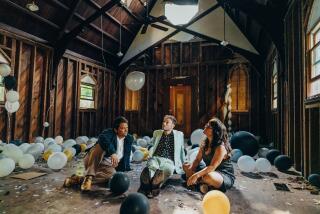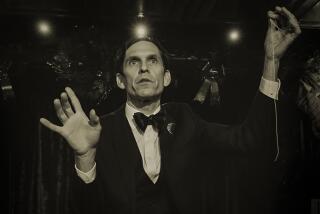Oh, When the Punks Came Blazing In : Slam Pits Aside, Misunderstood Art Form Was a Needed Jolt to a Tired Rock Scene
Once upon a time, Orange County was wild in the streets. Well, at least part of it was.
It’s been several years since I’ve attended punk rock concerts on any sort of regular basis, but in reading Mike Boehm’s two-part exploration of Orange County punk 10 years after it erupted from our quiet suburban streets (see story on Page 49-A), I realize that I miss punk. It’s with a sense of wicked pleasure that I think back on the wild and woolly scene that flourished here, however covertly.
Back then, the general perception was that walking into a Social Distortion concert at a Boys Club in Placentia, a T.S.O.L. show at the Galaxy in Fullerton, or a Fear performance at the Cuckoo’s Nest in Costa Mesa would be a harrowing experience. And that was precisely the point.
The clubs and rented halls frequently were like something out of a Fellini film--dark, dank holes filled with all manner of human oddities.
The scene one night at the Boys Club was unforgettable--and typical: Doors hadn’t opened on time and hundreds of fans swarmed around a rickety wooden ticket booth that had been set up outside. At one point, the ticket booth seemed to float of its own volition through the punk sea; actually, fans had picked it up and were carrying it away. While this was going on, the 22-year-old promoter of the show was standing out at the street trying to persuade the local constabulary that they had not indeed stumbled into the middle of the War of the Worlds.
A year or so earlier, it was while covering a 1980-81 New Year’s Eve show headlined by T.S.O.L. that my sense of curiosity about punk turned into sympathy for what the punks were up against.
It was held at an old, dilapidated movie theater in downtown Santa Ana, but contrary to the media image of punk shows as nuclear-war-in-a-box affairs, the crowd was fairly docile through the opening acts. Just before T.S.O.L. came on, the police riot squad rolled in--helmets on, batons in hand-- and cleared out the theater.
Officers requested that patrons please vacate the premises expeditiously. But not in those words. The official explanation the next day was that police were sent en masse because “someone” had reported a riot in progress outside the theater. From what I witnessed, there was no evidence of one.
The biggest crime was that these kids didn’t look or act like prep students, but more like the survivors of nuclear Armageddon who populated the “Mad Max” movies.
Precisely because punks were so visually dramatic, they were natural fodder for TV cameras. Most of the public’s ingrained fear of punk was TV’s fault, which always made the concerts look like political rallies in Berlin, circa 1933.
But often absent from the sensationalistic film of the punk movement that cropped up on TV (whenever ratings sweeps dictated a piercing 90-second look at the disintegration of America’s youth) was any sense of how much fun punk could be. There was a liberating energy that punk had, especially in its early years, that TV’s reportage on it always ignored.
Before the movement was usurped by Johnny Rotten-Come-Latelys interested only in punk’s outward symbols--the safety pins, the torn leather jackets, the physical contact of slam dancing--it was the refuge of the beautiful loser. And as often, the not-so-beautiful losers--the kids who were alienated from the majority of their peers and disenchanted with the mainstream rock music that radio was pushing at them.
If the scenario makes it sound like punk shows were isolating, depressing conventions for nerds, guess again. They were riotously (sometimes that was literally true) energizing celebrations.
Punk was a reaction against social conformity--which is very nearly a sacrament in this image-conscious county. This meant that the fans who first latched onto punk were those who coveted their individuality above all else.
While the draw ostensibly was whatever band happened to be hot at the moment--and punk was one of pop culture’s great moment-to-moment movements--the shows served a second, equally important function as a gathering place for teen-age misfits and outcasts.
Not troublemakers, per se. They came much later, Cro-Magnon types drawn by the idea of a place where you could throw a flying body slam without being sent to the penalty box.
Still, I usually went to punk shows alone--not out of choice, but because I had difficulty persuading most of my peers (I was about 10 years older than the average punk fan) that it was possible to emerge from a punk show without being tattooed against your will.
Certainly the concerts were flamboyant, with punk fans crashing into one another in the slam pit under a sound track that approximated Christmas Eve at LAX. It may have been called slam dancing, but in truth the slam pit was to dancing what the rodeo ring is to horseback riding.
Even so, a punk show was only something to fear if you weren’t familiar with one. As Cuckoo’s Nest owner Jerry Roach said at the time, “Fear is in the eye of the beholder--I can walk through a slam pit and not be afraid.”
There’s not much about the music itself that I pine for these days. As with rockabilly in the 1950s (or any highly stylized musical form) there was too little differentiation between the bands. Like Arthur Janov’s Primal Scream Therapy, punk was something you looked to for emotional catharsis, not intellectual insight.
I have preferred listening to most of the bands since they have grown beyond those limitations. T.S.O.L.’s anarchic flailing has given way to a more focused intensity and tightly woven songs. Social Distortion, the real bad boys of Orange County punk, have become thoughtful, and even melodic.
It was the early spirit of punk that I valued, and which didn’t last. It couldn’t. Like a nitro-fuel dragster, it burned hotter than anything else for a very short run. Punk rock wasn’t a vehicle that could take you the distance. It wasn’t supposed to. But boy, for a while, was it ever a blast.
More to Read
Sign up for Essential California
The most important California stories and recommendations in your inbox every morning.
You may occasionally receive promotional content from the Los Angeles Times.










